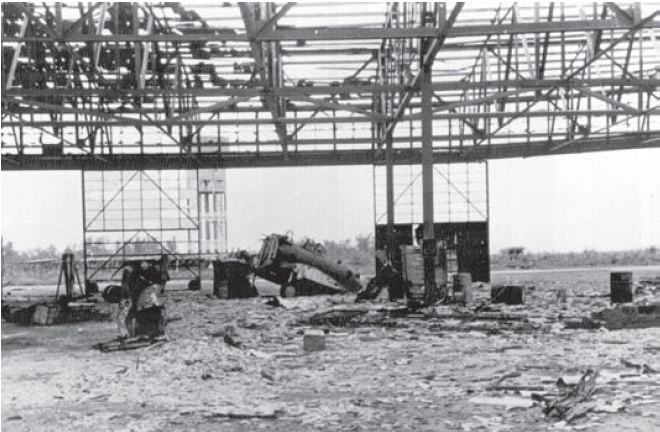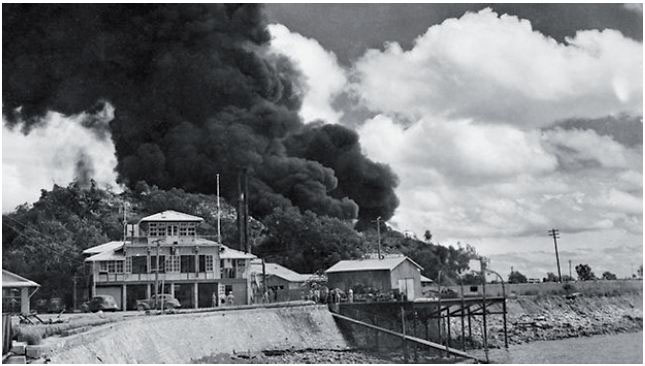Shortly before 1000h on 19 February 1942, 188 Japanese carrier aircraft arrived over the port city of Darwin and began attacking naval and civil shipping, harbour facilities and the city itself. While RAAF Station Darwin was also attacked during this raid, it was clearly not the focus of the bombing, with the waterside area taking the brunt of the main attack.
This was not the case when a second wave of 54 land based bombers arrived two hours later. This attack was aimed directly at the air base, causing extensive damage to aircraft, the airfield and related base infrastructure. In these two attacks, together lasting less than an hour, at least 243 people were killed with approximately 320 wounded, eight ships were sunk with a further 25 damaged, and 23 aircraft destroyed.
The purpose of the attack on Darwin was to prevent the place from being used to support counter-attacks against the planned Japanese invasions of Timor and Java. In this the raid was extremely successful. At the cost of about a half-dozen aircraft, Darwin was neutralised—if only temporarily—as a base of offensive operations.
The RAAF experience of the Darwin attacks was both positive and negative. Errors in leadership, airbase design and capability were counterpointed with courage, professionalism and evidence of an emerging air force with strategic depth. While not the RAAF’s finest hour, the Darwin experience is not the disgrace portrayed by popular myth.
Established only in 1939, RAAF Station Darwin was the first permanent RAAF presence in the far north of Australia and home to No 12 Squadron, consisting of a mixed establishment of Hudson, Anson and Wirraway aircraft. At the time of the attack the normal base complement was bolstered by elements of Nos 2 and 13 Squadrons that had withdrawn from the Netherlands East Indies. Yet while having gone onto a war footing, RAAF Station Darwin was still little more than a regional airfield with limited improvements to base infrastructure or personnel training necessary to provide some tolerance and defence against air attack.
This lack of preparation was despite warnings from a RAAF officer with extensive experience of Japanese air attacks on airfields in China. Squadron Leader Garnet Malley had witnessed the destructive force of Japanese air power and the vulnerabilities of airfields to aerial attack in the Sino-Japanese War, and he was well placed to advise RAAF station commanders on the passive and active defence options available to them.
Unfortunately, none of the recommendations made by Malley after visiting the Darwin base during 1941 were implemented prior to 19 February. The base’s facilities were not ‘hardened’ against air attack, being vulnerable to direct and indirect blast and shrapnel damage. These shortcomings, coupled with the concentration of base facilities into one small area, ensured more extensive damage than would otherwise have been the case.

The RAAF’s active defence measures were also similarly lacking. The ‘fighter’ force in Darwin consisted of a small number of Wirraway advanced trainers. While armed with two forward firing machine guns, these slow and relatively underpowered aircraft were never intended to be front line fighters. Even if the five Wirraway aircraft in Darwin had been serviceable, they would have been unable to intercept the bomber aircraft due to the lack of an efficient early warning and fighter control system.
The radar sent to Darwin to help establish such a system was still to be assembled (it was not operational until a month later), and the lack of faith in radar’s ability to locate and track incoming aircraft suggests a lack of education in the senior officers and training in more junior personnel. The overall lack of active defence measures was further underscored by the inadequacy of the anti-aircraft guns positioned around the airfield.
However, not every aspect of RAAF capability at Darwin was found wanting. Two emerging surveillance systems did in fact detect the incoming raids. Warnings were received from Melville and Bathurst Islands through an observation network, but unfortunately these sighting reports were taken for 10 US Kittyhawk fighters known to be in the area. Even so, the observation and coastwatch system around the north of Australia and throughout the south-west Pacific area would soon mature into a vital surveillance tool.

In addition to the observer network, the RAAF had a technology that also correctly predicted the incoming raid. A highly secret and covert radio interception section based at RAAF Station Darwin noted suspicious transmissions during the mid-morning. The intensity of signals then spiked alarmingly, followed by a total radio silence. The assessment of this radio traffic along with telltale bearing changes led the section to report that a raid was inbound. Here the secrecy and relative unknown capability of the radio interception section played against it, as their warning was not appreciated for what it was, and no action was taken. Like the observation network, the RAAF’s radio interception and analysis capability was later to develop well beyond the rudimentary system in place at Darwin and make a significant contribution to Australia’s intelligence services.
During the raid, many of the RAAF’s personnel responded to the crisis admirably. The Administration Officer, Squadron Leader Andrew Swan, and Warrant Officer Chapman operated a Lewis gun throughout the first wave, supported by at least 50 other RAAF members who also engaged the enemy aircraft with machine guns and rifles. The first RAAF casualty of the raid was one of these defenders, Wing Commander Archibald Tindal, who was killed as he fired a Vickers gun from the edge of a trench.
When the first attack ended, Swan led a group of airmen into a burning hangar to retrieve ammunition from a store, while others secured an ammunition-laden truck away from other burning wreckage. All around the base personnel went to work endeavouring to create order out of chaos. In the confusion after the final attack when an order to regroup half a mile from the base was misinterpreted by many as an evacuation order, Swan again took charge of the situation and managed to direct large numbers of RAAF personnel back to the base and on to essential recovery tasks. It is unfortunate that the achievements of so many RAAF members are overshadowed by the often exaggerated stories of desertion and panic.
The air raid on Darwin was a wakeup call to many in Australia—in the age of air power, no country was safe from attack. In the reconstruction of Darwin, RAAF Station Darwin was built up with radar networks, command and control systems as well as a fighter wing, including the first operational Spitfire squadrons in Australia. Attacked an additional 63 times, Darwin never again suffered as it did on 19 February 1942.
• The active and passive defence mechanisms of airbases are a product of initial design, investment in capability and sustained through well-trained and equipped personnel.
• The integration of surveillance and reporting systems into C2 networks is essential, as is the training and exercise of the systems in order to refine their efficiency.
• While not the RAAF’s finest hour, the experience of the Darwin bombing demonstrated the RAAF’s growing capabilities as well as the enduring qualities of a majority of its personnel.
It is essential for aerial defence of Darwin to have fighter squadrons. These of course, must have adequate ground organisation and defence, and there must be proper dispersion of the aircraft to prevent, or at least minimise loss on the ground. Justice Charles Lowe, Commission of Enquiry into the Darwin Bombing, 27 March 1942
Pathfinder Bulletin No 171, February 2012. Reprinted with permission.
Contact Office of Air Force History about this article.






